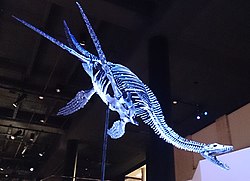เพลสิโอซอร์
| เพลสิโอซอร์ ช่วงเวลาที่มีชีวิตอยู่: ปลายยุคไทรแอสซิก - ปลายยุคครีเตเชียส, 203.6–66.0Ma | |
|---|---|

| |
| ตัวอย่างของโครงกระดูกเพลสิโอซอรัส (Plesiosaurus dolichodeirus) | |
| การจำแนกชั้นทางวิทยาศาสตร์ | |
| อาณาจักร: | Animalia |
| ไฟลัม: | Chordata |
| ชั้น: | Reptilia |
| อันดับใหญ่: | †Sauropterygia |
| ไม่ได้จัดลำดับ: | †Pistosauria |
| อันดับ: | †Plesiosauria de Blainville, 1835 |
| อันดับย่อย | |
| |
เพลสิโอซอร์ (อังกฤษ: Plesiosaurs; /ˌpliːsiəˈsɔːriə, -zi-/;[1][2] กรีกโบราณ: πλησίος, plesios, หมายถึง "ใกล้ถึง" และ Sauria หมายถึง กิ้งก่า) เป็นกลุ่มของสัตว์เลื้อยคลานทะเลขนาดใหญ่ที่สูญพันธุ์ไปแล้ว ตั้งแต่ยุคครีเตเชียสเมื่อราว 65 ล้านปีก่อน ที่อยู่ในอันดับ Plesiosauria
เพลสิโอซอร์ ปรากฏตัวตั้งแต่ยุคไทรแอสซิกตอนปลาย (ประมาณ 230 ล้านปีก่อน[3]) มีคอยาว แต่หัวเล็ก ในปากมีฟันแหลมคม สามารถว่ายน้ำได้อย่างรวดเร็วคล่องแคล่ว และสามารถลอยตัวผ่านน้ำได้ ฟันมีลักษณะรูปกรวยมีความแหลมคมแข็งแรงมากพอที่จะฆ่าสัตว์น้ำต่าง ๆ กินเป็นอาหารได้ และด้วยความยาวลำตัวที่มากถึง 15 เมตรเป็นอย่างน้อย จึงทำให้เพลสิโอซอร์ได้ชื่อว่าเป็นอสุรกายแห่งท้องทะเลในยุคก่อนประวัติศาสตร์ด้วยความที่เป็นสัตว์นักล่าที่อยู่บนสุดของห่วงโซ่อาหาร
ทั้งนี้ เพลสิโอซอร์มีอยู่ด้วยกันหลายชนิด เช่น อีลาสโมซอรัส (Elasmosaurus platyurus), เพลสิโอซอรัส (Plesiosaurus dolichodeirus) หรือฟุตาบะซอรัส (Futabasaurus suzukii) พบกระจายพันธุ์ในท้องทะเลต่าง ๆ ทั่วโลก ตั้งแต่แถบอาร์กติกจนถึงขั้วโลกใต้ในปัจจุบัน เชื่อกันว่าเพลสิโอซอร์ล่าสัตว์น้ำต่าง ๆ เช่น ปลา, หมึก กินเป็นอาหาร แต่ก็มีบางทฤษฎีที่เชื่อว่าเพลสิโอซอร์ไม่สามารถยกส่วนหัวหรือคอขึ้นพ้นผิวน้ำได้ และจากการศึกษาล่าสุดของนักบรรพชีวินวิทยากลุ่มหนึ่ง โดยการใช้แบบจำลองส่วนหัวและฟันของเพลสิโอซอร์พบว่า การสบกันของฟันอาจเป็นไปได้ว่าใช้ชีวิตด้วยการกรองกินเหมือนกับวาฬบาลีนหรือวาฬไม่มีฟัน ซึ่งไม่เคยพบพฤติกรรมเช่นนี้ในสัตว์เลื้อยคลานทางทะเลชนิดอื่น ๆ มาก่อน โดยอาจเป็นวิวัฒนาการเบนเข้า เนื่องจากทั้งวาฬและเพลสิโอซอร์นั้นมิได้มีส่วนใดเกี่ยวข้องกันเลยแต่ประการใด แต่ทั้งนี้ก็ยังต้องเป็นเรื่องที่ต้องศึกษากันต่อไป[4]
โดยเพลสิโอซอร์ มักถูกอธิบายว่าเป็นสัตว์ที่ยังหลงเหลืออยู่มาจนถึงปัจจุบัน อันเป็นที่มาของสัตว์ประหลาดทะเลสาบตลอดจนสัตว์ประหลาดทะเลหรือมังกรทะเล ที่พบตามแหล่งน้ำต่าง ๆ จนถึงทะเลหรือมหาสมุทรทั่วโลก เช่น เนสซี หรือสัตว์ประหลาดล็อกเนสส์ในสก๊อตแลนด์, มอแรก ในสก๊อตแลนด์, แชมป์ ในพรมแดนสหรัฐอเมริกาและแคนาดา, โอโกโปโก ในแคนาดา เป็นต้น[5]
อ้างอิง
- ↑ "Plesiosaur". Merriam-Webster Dictionary.
- ↑ "Plesiosaur". Dictionary.com Unabridged. Random House.
- ↑ "The Plesiosaur Directory". คลังข้อมูลเก่าเก็บจากแหล่งเดิมเมื่อ 2016-03-04. สืบค้นเมื่อ 20 April 2013.
- ↑ หน้า 7 วิทยาการเกษตร-เกษตร, สืบค้นวิวัฒนาการของสัตว์เลื้อยคลานดึกดำบรรพ์เพลสิโอซอร์. "โลกโศภิณ". ไทยรัฐปีที่ 68 ฉบับที่ 21786: วันพฤหัสบดีที่ 14 กันยายน พ.ศ. 2560 แรม 9 ค่ำ เดือน 10 ปีระกา
- ↑ เนสซีมาแล้ว หน้า 40, "โลกเร้นลับของสิ่งมีชีวิต" แปลโดย ขวัญนุช คำเมือง (พิมพ์ครั้งที่ 5 กรุงเทพฯ : นานมีบุ๊คส์ มกราคม 2543) ISBN 974-472-262-2
เอกสารอ่านเพิ่มเติม
- Carpenter, K (1996). "A review of short-necked plesiosaurs from the Cretaceous of the western interior, North America". Neues Jahrbuch fuer Geologie und Palaeontologie Abhandlungen (Stuttgart). 201 (2): 259–287.
- Carpenter, K. 1997. Comparative cranial anatomy of two North American Cretaceous plesiosaurs. Pp 91–216, in Calloway J. M. and E. L. Nicholls, (eds.), Ancient Marine Reptiles, Academic Press, San Diego.
- Carpenter, K (1999). "Revision of North American elasmosaurs from the Cretaceous of the western interior". Paludicola. 2 (2): 148–173.
- Cicimurri, D.; Everhart, M. (2001). "An Elasmosaur with Stomach Contents and Gastroliths from the Pierre Shale (Late Cretaceous) of Kansas". Trans. Kansas. Acad. Sci. 104 (3 &, 4): 129–143. doi:10.1660/0022-8443(2001)104[0129:AEWSCA]2.0.CO;2.
- Cope, E. D. (1868). "Remarks on a new enaliosaurian, Elasmosaurus platyurus". Proceedings of the Academy of Natural Sciences of Philadelphia. 20: 92–93.
- Ellis, R. 2003: Sea Dragons (Kansas University Press)
- Everhart, M. J. (2002). "Where the elasmosaurs roamed". Prehistoric Times. 53: 24–27.
- Everhart, M.J. 2005. "Where the Elasmosaurs roamed," Chapter 7 in Oceans of Kansas: A Natural History of the Western Interior Sea, Indiana University Press, Bloomington, 322 p.
- Everhart, M.J. 2005. Oceans of Kansas: A Natural History of the Western Interior Sea. Indiana University Press, Bloomington, 322 pp.
- Everhart, M.J. (2005). "Gastroliths associated with plesiosaur remains in the Sharon Springs Member (Late Cretaceous) of the Pierre Shale, Western Kansas". Kansas Acad. Sci. Trans. 103 (1–2): 58–69.
- Everhart, Michael J (2006). "The Occurrence of Elasmosaurids (Reptilia: Plesiosauria) in the Niobrara Chalk of Western Kansas". Paludicila. 5 (4): 170–183.
- Hampe, O., 1992: Courier Forsch.-Inst. Senckenberg 145: 1-32
- Lingham-Soliar, T. (1995). "in". Phil. Trans. Roy. Soc. Lond. 347: 155–180.
- O'Keefe, F. R. (2001). "A cladistic analysis and taxonomic revision of the Plesiosauria (Reptilia: Sauropterygia);". Acta Zool. Fennica. 213: 1–63.
- ( ), 1997: in Reports of the National Center for Science Education, 17.3 (May/June 1997) pp 16–28.
- Kaddumi, H. F., 2009. Fossils of the Harrana Fauna and the adjacent areas. Publications of the Eternal River Museum of Natural History, Jordan. 324 pp.
- Storrs, G. W., 1999. An examination of Plesiosauria (Diapsida: Sauropterygia) from the Niobrara Chalk (Upper Cretaceous) of central North America, University of Kansas Paleontologcial Contributions, (N.S.), No. 11, 15 pp.
- Welles, S. P. 1943. Elasmosaurid plesiosaurs with a description of the new material from California and Colorado. University of California Memoirs 13:125-254. figs.1-37., pls.12-29.
- Welles, S. P. 1952. A review of the North American Cretaceous elasmosaurs. University of California Publications in Geological Science 29:46-144, figs. 1-25.
- Welles, S. P. 1962. A new species of elasmosaur from the Aptian of Columbia and a review of the Cretaceous plesiosaurs. University of California Publications in Geological Science 46, 96 pp.
- White, T., 1935: in Occasional Papers Boston Soc. Nat. Hist. 8: 219-228
- Williston, S. W. 1890. A new plesiosaur from the Niobrara Cretaceous of Kansas. Transactions of the Kansas Academy of Science 12:174-178, 2 fig.
- Williston, S. W. (1902). "Restoration of Dolichorhynchops osborni, a new Cretaceous plesiosaur". Kansas University Science Bulletin. 1 (9): 241–244, 1 plate.
- Williston, S. W. 1903. North American plesiosaurs. Field Columbian Museum, Publication 73, Geology Series 2(1): 1-79, 29 pl.
- Williston, S. W. (1906). "North American plesiosaurs: Elasmosaurus, Cimoliasaurus, and Polycotylus". American Journal of Science. 21 (123): 221–234, 4 pl.
- Williston, S. W. (1908). "North American plesiosaurs: Trinacromerum". Journal of Geology. 16: 715–735. Bibcode:1908JG.....16..715W. doi:10.1086/621573.
แหล่งข้อมูลอื่น
- The Plesiosaur Site. Richard Forrest.
- The Plesiosaur Directory. Adam Stuart Smith.
- Plesiosauria เก็บถาวร 2017-07-12 ที่ เวย์แบ็กแมชชีน technical definition at the Plesiosaur Directory
- Plesiosaur FAQ's. Raymond Thaddeus C. Ancog.
- Oceans of Kansas Paleontology. Mike Everhart.
- "Plesiosaur fossil found in Bridgwater Bay เก็บถาวร 2007-03-13 ที่ เวย์แบ็กแมชชีน". Somersert Museums County Service. (best known fossil)
- "Fossil hunters turn up 50-ton monster of prehistoric deep เก็บถาวร 2011-06-04 ที่ archive.today". Allan Hall and Mark Henderson. Times Online, December 30, 2002. (Monster of Aramberri)
- Triassic reptiles had live young เก็บถาวร 2005-11-03 ที่ เวย์แบ็กแมชชีน.
- Bridgwater Bay juvenile plesiosaur เก็บถาวร 2007-03-13 ที่ เวย์แบ็กแมชชีน